Advisory Series: Mobile and Modern Working
- 11 July 2018
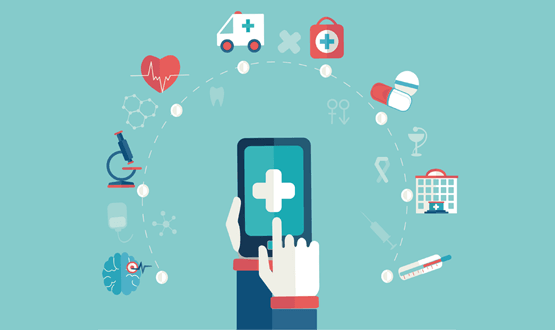
Mobile and Modern Working – Advisory Series, July 2018

By Maja Dragovic – Digital Health
With increasing emphasis being placed on community healthcare, efficient ways of working are imperative in order to meet the increasing demand. Using mobile technology is viewed as one way in which this can be achieved. Though progress has been made, there is still further to go. Maja Dragovic reports.
In a recent survey conducted by the Queen’s Nursing Institute (QNI), over 500 community nurses have expressed their views on the use of IT in their area and most found it was used effectively when it was working. Most also viewed the ability, provided by the modern technology, to access and share patient information amongst health professionals as invaluable.
“Our system allows us instant access to our consultants and clinical colleagues ‘at the touch of a button'”, said one of the respondents in the survey.
Apart from the usual ways in which IT supports service delivery of patient care in the community, such as data collection, the report found there are also more innovative ways in which technology was utilised, such as monitoring wounds through photography, eClinic instant messaging and virtual consultations.
Another report published recently by the Royal College of Nursing (RCN) also found that nurses across the NHS cited improvements in patient outcomes when using texting services (such as eClinic) and websites for young people to discuss health issues.
Though there are a lot of good examples of using technology to improve patient care, “the problem is they are pockets of examples”, says Anne Cooper, former chief nurse at NHS Digital. “It is true to say that we haven’t got exemplars everywhere.”
Matthew Bradby, head of communications at QNI, agrees: “It is getting better but it is a slow process”.
So what are the problems?
According to the RCN survey, the obstacles to making the most of digital tools are mostly unnecessary and should be easy to overcome.
“The responses to our survey reveal some depressingly mundane barriers to nurses’ full participation in digital transformation, from WiFi that doesn’t work, to computers that take too long to log on, interference from medical equipment and outdated operating systems like Windows 7”, says Ross Scrivener, eHealth lead at the RCN.
Laptops and tablets
Inadequate equipment is cited in both reports as one of the major problems. Over 40% of respondents in QNI’s survey used laptops to capture information but it often added to their workload rather than reducing it.
It is “really effective when it works adequately but substantial amount of time is wasted due to inadequate equipment. Laptops are not fit for purpose due to issues with signal, memory etc. which is frustrating at times,” said one of the nurses.
Though iPads and tablets are still not widely used, some of the nurses who do use them think tablet devices are unsuitable for mobile working.
“We have to struggle with iPad mini with no keypad docking station to make typing easier. Instead of being able to type properly, it takes ages stabbing away at the small screen with one finger,” one QNI report contributor explained.
It other cases, although some trusts have set up the IT system for patient records, the district nurses don’t have access to handheld devices.
According to one respondent: “My trust has set up the digital network, but as district nurses, we do not have access to the mobile equipment. Therefore, we have to complete paperwork at home, including full assessments, then take the information back to base and input onto the EMIS system. This is a waste of nurses’ valuable time.”
Poor connectivity
For those community nurses that do have access to handheld devices, poor internet access was a significant challenge to working in the community. This often results in system running slowly or crashing.
“The systems in place are severely slow and crash continuously,” one respondent to the QNI survey said. “They take hours to complete overall rather than minutes. I am a person who enjoys technology, however in this case I find it reduces productivity and causes a handicap rather than making life easier.”
“I think it’s partly because a lot of the software is hosted on the remote servers. I think a lot of it is poor connectivity, because nurses are out and about and the portable and mobile devices that they are using are losing connectivity”, suggests Bradby.
“The UK is criticised for not having enough investment in digital technology. The problem is not just in rural areas, lots of areas are affected by bad connectivity.”
Regardless of the problems encountered by those who use mobile technology, there are still many nurses who rely on paper for record keeping due to lack of digital skills.
“Let’s not forget that some of the workforce started with pen and paper, and the support has not always been there to help them move along as new technology has been introduced”, a respondent in QNI’s survey suggested.
Incompatible systems
Another area of concern is that a multiplicity of IT suppliers has led to the use of databases and systems which are incompatible with one another. There were 67 differently named IT systems in community healthcare in the QNI report alone.
This leads to massive variations in terms of how people are trained on systems, “because the way the system works is that there is no single way”, says Cooper.
A number of respondents in QNI survey also found the systems in place as being too complex, which leads to work being duplicated and capturing information accounted for a significant amount of time.
Bradby suggests the problem lies with wrong systems being purchased. “What may be happening in community healthcare is that they might be buying software that was developed for other situations like hospital settings and then they’re trying to adapt it. The process is always more difficult then they think.”
This view is also reflected in the QNI report.
“Needs of hospital-based and community-based technologies are different and this was not considered before implementation in the community”, was a response from one of the nurses in the report.
The RCN survey also found that systems have been adapted and applied to community nursing without much input from the nurses. Since nurses are the largest professional group in healthcare, not including them is viewed as part of the problem.
“Nurses are not at the table, they are given the technology, and then they are expected to use it rather than being asked what the technology needs to look like”, Cooper says. “Nurses have a vision for how technology can help them but the basics are often not quite right. For example, they have to log on multiple times and there’s a consequence of that.”
Cooper adds that the nurses’ vision for what technology must look like is much simpler than the one offered by IT providers.
“They (the nurses) are just saying ‘please just get the basics right.'”
Keeping it simple is, indeed, a must, according to one contributor in the RCN report:
“As a nurse, my dream would be to go online and see any patient’s records that I needed to see. They would be together, well-curated, under the patient’s name/identifier. It would include GP, acute, community interventions and interactions and all correspondence. There would be click through contact points for details of other staff involved.
“As a patient, my dream would be the same.”
Support that Serves Everyone, Securely
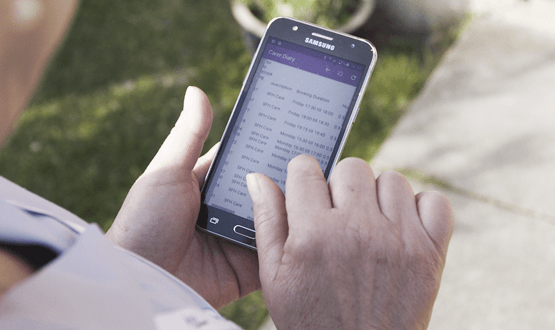
By Gregg Hardie – Head of Public Sector, Samsung
At Samsung, we appreciate the current pressure on the UK healthcare sector to become more efficient, productive and secure, within reduced budgets. At the same time, we know there’s been an overarching drive to perform a complete digital transformation and go paperless, which requires significant and ongoing investment in new technology.
The case for mobile in healthcare
Mobile technology continues to advance at an exponential rate, enabling more innovative and advanced treatment, diagnostics and care to be provided to patients. It’s not just a technology upgrade for some healthcare workers; it’s more of a culture change that certain people could find more challenging.
It is a culture change that must happen though. Nuffield Trust produced a report1 in 2017 that revealed 75% of the UK population search for health information online, and that there are more than 165k health-related apps on the market, so patient expectations have very definitely been digitised. That said, more and more people in the healthcare sector are exploring the benefits of mobile working to increase efficiency, reduce costs and improve patient outcomes. A report by Samsung and Digital Health2 revealed that 90% of NHS staff used their mobile at work, and 91% used it for working remotely; with 96% seeing increased benefits.
The ability to access patient records remotely means healthcare professionals can reduce the amount of unnecessary travelling to and from work, so they can be considerably more efficient in their roles and care for more patients. This also prevents the duplication of work, as digital records can be accessed by all relevant parties. Plus, going mobile means healthcare staff and patients are better connected, making feedback easier, and enabling more patient-centric care to be provided.
“I don’t always have to get out of bed when I get a call at night now. I can access patient records from my bed and very often remove the need to go out. And that’s a massive plus.”
Professor Joe McDonald, CCIO, Northumberland, Tyne and Wear NHS Foundation Trust and chair, CCIO Network
A healthy approach to data security
Digital transformation means patient care can be based on more data; speeding up diagnosis, increasing patient safety, and enabling better treatment and care. However, the introduction of GDPR this year means healthcare organisations now face significant fines if they fail to adequately protect patient data. Added to this concern is the growing incidence of cyber attacks, which only seem set to increase over the coming years. The ‘WannaCry’ attack in May 2017 affected almost 35% of English NHS trusts and caused significant disruption; so understandably, security is still a major barrier to going digital for healthcare organisations.
Security is of paramount importance to Samsung, which is why we integrate Samsung Knox into a wide range of Samsung devices, at both a hardware and software level. It provides defence grade mobile security that’s trusted by governments around the globe. Galaxy devices also offer a range of advanced biometric security features, like iris and fingerprint scanning, and facial recognition technologies, which help to keep patient records safe and sound.
Service Anywhere – breaking down barriers for the healthcare sector
We realise healthcare organisations have huge fleets of devices that need to be kept up-to-date and operational. We also understand that technology implementations on this scale can be costly, convoluted, and incredibly challenging. To address this, Samsung has created Service Anywhere; a service package that puts the latest technology within easy reach of healthcare organisations. We have also backed it up with a simple ongoing service and maintenance plan, to help slash the time spent on routine tasks, by making expert care available whenever it’s needed.
Our standard service package has been designed to give healthcare organisations everything they need for a smooth and reliable technology service. It also helps them get back up and running quickly, if they experience technical issues. Starting with a welcome call to ensure users are comfortable using their new technology from the very start, downtime can be minimised during device roll-out. ServiceHub allows organisations to register all their devices and keep a live view of all their tech, including warranty dates, service entitlements, and locations of deployed technology. For those who like to learn about their devices and how to get the most out of them, Managed Services customers can access our online knowledge base and device simulator, Samsung Enterprise Support. This also allows users to find answers to common questions quickly.
Telephone support reduces the pressure on internal IT teams, meaning they don’t lose time helping staff having issues using their devices. Whether they are experiencing a device fault, need support with setting up email, or help transferring data between devices; they have a dedicated IT team on-hand to help. This is further enhanced by remote support, which enables the IT team to remotely connect to devices and resolve issues quickly and efficiently, without having to repair or replace them. Plus, if there’s a fault with a device that can’t be resolved remotely, devices can either be replaced like-for-like with a new device, be collected and repaired, or be repaired at one of our UK service centres.
To create an even more comprehensive support package, there are ‘value add’ packs that can be bought to complement the standard service. These packs cover screen replacement when they become cracked, which can be a hygiene issue in healthcare environments. Staging and provisioning takes the hassle out of deploying devices. We can also pre-configure assets before they are deployed, including anything from device settings updates, firmware flashing, installing accessories and creating Google accounts, to arranging home screens and activating MDM settings. Plus, if an organisation is using Samsung Knox, we’ll register all their Knox licenses too.
Finally, in our additional Disposal and Data Wipe service, Samsung arranges for a company’s existing out of date technology to be taken away – regardless of brand, age and condition. All data is wiped, and devices are repaired and refurbished, before giving organisations the net value back against their new Samsung technology. This additional service adheres to both UK and US government defence standards, so stored information and data is completely secure; and it can help reduce the capital expenditure required to make much-needed technology upgrades.
The healthcare sector continues to face challenges as the burden of demand grows and technology advances. Digitisation is no longer a question of if, but how and when. At Samsung, we help people do what they can’t, and we’re proud to be enabling the UK healthcare sector to provide outstanding levels of care long into the future. If you would to learn more about Samsung’s work in healthcare, please contact Helen Shaw at h.shaw@samsung.com or call 07896 873 125.
 |
|
| Point of contact: Helen Shaw Contact number: 078 9687 3125 Email: h.shaw@samsung.com Our website: www.samsung.com [ssba]
|
|
1Castle-Clarke S and Imison C (2016) The digital patient: transforming primary care? Nuffield Trust
2Upwardly Mobile: The rise of mobile working in healthcare – exploring the benefits, the barriers and the opportunities by Digital Health Intelligence and Samsung
Why enabling your staff with mobile clinical decision support is good news for everyone
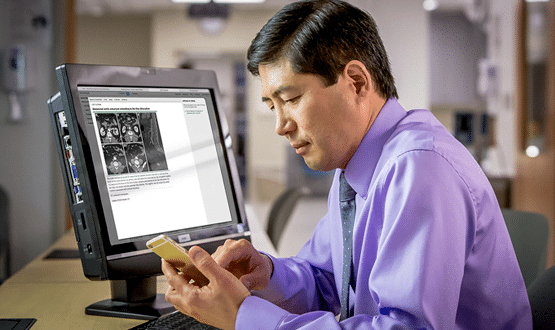
By Rob Wake – Wolters Kluwer
For doctors and nurses on the run all day, talking to patients in clinic, on the hospital ward, or even in- home visits, the miniaturisation of technology has yielded huge benefits in the form of mobile platforms. The encyclopedia of medical knowledge is now at clinicians’ fingertips, wherever they are. And it is constantly being updated with the latest evidence-based clinical research.
Not only does clinical decision support on the mobile device offer doctors the chance to feel smarter, faster, on whatever topic they are looking up. It also helps them build trust with the patient in the chair or the hospital bed in front of them.
Patients respond very positively to the use of mobile technology such as UpToDate® during a consult, says Dr. Steve Jackson. “They are perfectly happy for me to say, ‘Let’s look this up together, to make sure I am doing the right thing.’ ”
Jackson is an evangelist for mobile technologies at University Hospitals of Leicester NHS Trust, one of the biggest and busiest NHS Trusts in the country, serving a million residents of Leicester, Leicestershire, and Rutland. He is chief medical information officer and a consultant in diabetes and endocrinology at the trust.
If Dr. Jackson is using his laptop computer, he turns the screen toward the patient and explains what he’s looking up and how to understand the medical terminology.
“I am completely honest with them. I don’t know everything about medicine,’ I tell them, ‘so let’s look it up.’ I would say, ‘This is stuff for you. Would you like me to send it to you as an email?’ “Everybody has always said yes.” As a result, these patients engage more fully in their own diagnosis and care plan.
NHS Digital is making clinical decision support at the point of care a high priority. It has developed a toolkit to assist chief information officers, chief clinical information officers, commissioners, providers and their teams to learn to use these mobile technologies for maximum benefit. That includes not just improving quality of care, but also raising productivity and efficiency of the medical staff by service transformation at the point of care.
The toolkit gives local hospitals, clinics, and Trusts a roadmap to finding the solutions that best fit their specific needs. The ultimate goal is to go paperless by 2020.
For many NHS clinicians, Jackson says, the mobile apps are not yet connected to the patient’s medical record, which is still recorded by hand on paper. That is sure to change in the coming years as NHS organisations accelerate their digitisation programmes. Global providers of CDS such as Wolters Kluwer are working in partnership with EPR suppliers to integrate their solutions, a move that has resulted in a significant increase in EPR usage and satisfaction on the part of clinicians.
For now, though, the priority of the NHS is to facilitate “some relatively easy and significant wins,” in the words of a report by Nuffield Health, The most prominent quick wins would be “vital signs monitoring and support for mobile working.”
The Nuffield report, titled “Delivering the Benefits of Digital Health Care,” notes the great appeal of the “leading edge of the technology boom – applications (‘apps’), big data, the ‘internet of things’,” and so forth. But it goes on to suggest that there is still huge scope for major improvements in quality and productivity from the use of information systems “that are available now and which are required if organisations are going to be able to benefit from the more futuristic ideas coming over the horizon.”
Dr Simon Eccles, who became NHS chief clinical information officer in February, commented on the “lure of new innovations” that threaten to divert resources away from more critical projects. The collective challenge to the NHS is “to do what we said we’d do and not be too distracted by new and shiny things,” he said.
More can be delivered in the short term by investing in clinical decision support at the patient’s side. Other NHS Trusts, such as University College London Hospitals NHS Foundation Trust and Bolton NHS Foundation Trust, are innovating and seeing positive results with the use of on-the-go decision support solutions.
As of 2016, NHS England found in a Digital Maturity Assessment, only 61% of community provider organisations felt their workforce were equipped with mobile devices to access data at the point of care Only 39% of provider organisations could use digital systems to alert professionals of early warning scores or deteriorating clinical observations. Obviously there is plenty of opportunity to grow a more robust digital experience for providers and patients.
A fuller implementation of mobile technology in support of clinical decision-making could conserve scarce NHS resources by refining the diagnostic algorithm, Dr. Jackson suggests. “When you have patients whose diagnosis is not clear, then there is a tendency to over-investigate, doing tests that have no evidence base behind them, in a scatter- gun approach,” he says. “If you have a diagnosis in mind as a possibility, then using [clinical decision support] to find out what the evidence-based testing regime is, this allows you to do the tests that are important without doing tests that are unimportant.”
Recent innovations include interactive intelligent algorithms that guide clinical decisions by combining patient contextual information with the latest evidence base. These solutions – such as UpToDate® Advanced™ – help doctors provide consistent quality and appropriate care to all patients fast, without taking away their autonomy.
Having clinical decision support at your fingertips also means clinicians can deliver consistent and high-quality care in any setting, because they are using the same evidence-based resource. This helps reduce unwarranted variation in care and reinforces consistency across the organisation.
Doctors have a natural tendency to follow a care management protocol that they learned from a senior doctor some years earlier, Dr. Jackson notes. “This was in the days when everybody did what they thought was the right thing, possibly because they learned it from their boss. Having an evidence-based guideline to manage that condition will reduce clinical variation. That makes patient care safer as well as more efficient.”
On the hospital ward, Jackson uses a laptop device, while his junior colleagues more frequently use a tablet or mobile phone. The mobile clinical decision support is an important offering for his trainee colleagues in Leicester, he says. “It’s a nice succinct way of finding how to manage conditions, what symptoms are. You can do searches for diagnoses. It’s very easy to read.”
Not only does it help them understand the case in front of them, it helps them track their continuing professional development and their exams. Offering the clinical decision support is “part of our advertising to keep junior doctors working for us, to attract new junior doctors. They are more likely to feel valued if we give this to them free of charge, not only to use at the work place but at home.”
Rob Wake is the country manager for UpToDate in the UK and Ireland. UpToDate is an evidence-based, physician-authored clinical decision support resource by Wolters Kluwer. Wolters Kluwer N.V. (AEX: WKL) is a global leader in information services and solutions for professionals in the health, tax and accounting, risk and compliance, finance and legal sectors.
 |
|
| Our website: www.wolterskluwer.com/ Twitter: @Wolters_Kluwer LinkedIn: www.linkedin.com/company/wolters-kluwer Facebook: www.facebook.com/wolterskluwer [ssba]
|
|
Adaptive, responsive, limitless: leading digital change in health and social care working practices
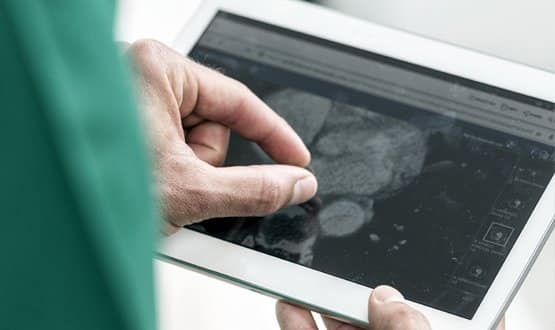
By Paul Jackson – Head of Marketing, Agfa Healthcare
How are NHS and healthcare organisations, working in partnership with Agfa HealthCare, adapting to modern and mobile working?
Agfa HealthCare helps healthcare organisations deliver better care. We do this through a range of digital health products and solutions, and through over 100 years of healthcare experience.
Digital health is a multidisciplinary domain which involves many stakeholders. Agfa’s Digital Health range covers three main IT product areas:
- Enterprise Imaging – PACS, RIS, VNA, Image Viewer, Image Exchange, Cloud
- Hospital IT – EMR
- Integrated Care – EHR, care information exchange, image sharing, patient engagement
As the NHS celebrates its 70th birthday, working practices and access to systems have changed dramatically over time, especially in the last decade as hospitals have become increasingly paper-lite. Mobile access and working functionality are now expected and fundamental requirements of Agfa HealthCare’s Digital Health portfolio – an interoperable ecosystem of data capture, exchange, share and collaboration with advanced tools for analytics – have become the foundation for the transformation of health and social care.
We have recently been working closely with Princess Alexandra Hospital, the Yorkshire Image Collaborative, Alliance Medical Ireland, Royal Derby Hospital and Republic of Ireland and Northern Ireland Clinicians to support mobile and modern working practices and the adoption of technology within health and social care.
Enterprise Imaging with Princess Alexandra Hospital
Our Enterprise Imaging solution is a single, sophisticated, unified imaging platform. Having all imaging data available from one single imaging interface across web and mobile platforms allows users to work where they want, how they want, letting Clinicians view images, videos, studies and work on reports. The ‘lightweight’ client lets users create, edit and approve reports remotely, from a mobile device. With real-time collaboration, the ways of direct messaging and sharing that we have become so used to using every day are available securely within Enterprise Imaging, enabling acquisition, sharing, reviewing and reporting on all kinds of imaging data.
Princess Alexandra Hospital recently went live with Enterprise Imaging and is already seeing the benefits. Sub-1-second system response times for image retrieval, significantly reduced plain film reporting times and 100% voice recognition have all contributed to the reduced turnaround speed of reporting. In addition, the web-based XERO Image Viewer with Xtend provides Clinicians with secure access to reports and images and enables them to review MPRs and 3D images ‘on the fly’.
The Yorkshire Imaging Collaborative with XERO Universal Image Viewer
Agfa’s Universal Image Viewer, XERO, provides secure access to imaging data from different departments and multiple sources, in one view, to anyone who needs it. The XERO footprint web viewer allows Clinicians to work on the go, capturing and uploading images. Using streaming technologies, information is displayed in the XERO footprint web viewer from the server, meaning that no patient information is stored locally on mobile devices.
XERO Universal Image Viewer is part of the first phase of the Yorkshire Imaging Collaborative, a project that will enable transformative change across the radiology services of 8 NHS Trusts, including 24 NHS Hospitals.
Whilst some trusts are already using XERO the project will connect over 10,000 users and provide Clinicians across the 8 Trusts with secure access to images and reports via a web viewer, at the point of care. This will reduce the need for exchange technologies which can delay and provide imaging data at a point in time, rather than the latest real-time imaging data. The XERO viewer also supports a ‘look and leave’ strategy when Clinicians simply need to quickly view real-time imaging data, avoiding the need to transfer it.”
XERO will also be embedded into Trusts EMRs so that imaging data can be viewed alongside other information. This XERO deployment and connectivity is expected to be live before the end of 2018.
Home Working and Remote Reporting with Alliance Medical Ireland
Agfa HealthCare’s Remote Reporting has enabled Alliance Medical Ireland to offer Radiologists a highly productive mix of home- and site- based reporting. Images are taken at their scan centres and reported on by our team of subspecialist consultant radiologists at various locations.
In the first phase, Home Reporting users are supplied with an encrypted laptop connected to appropriate medical grade displays connected to Alliance Infrastructure via a software VPN. This deployment allows Alliance Medical to effectively manage reporting availability with Radiologist(s) independent of location. Using only mid-range laptop and simple VPN and broadband requirements, consultants can do their normal work in a home reporting environment. Remote Reporting enhances Radiologist convenience and productivity, and supports the increasing capacity of the radiology services, including on-call radiology.
Paperless ICU for Royal Derby Hospital
ORBIS, Agfa’s Electronic Patient Record solution provides functionalities as part of the ORBIS Mobile Edition (ME) on devices at the patient’s bedside and beyond, providing the Clinician with relevant information, right where it’s needed. Using ORBIS ME, Clinicians can capture, share and access patient information from anywhere in the hospital on a tablet device, providing a fast overview of the patient record and supporting care providers during their daily activity.
Using Agfa HealthCare ORBIS ICU-Manager, Royal Derby Hospital is implementing a ‘paperless’ ICU strategy for its Adult Critical Care Units. The ‘paperless’ and mobile-compatible of ORBIS ICU-Manager enables the automated collection of data from monitors and devices, removing the need for transcription. This helps reduce the risk of potential errors – for better patient care and safety, and enhances efficiency, leading to cost improvements.
Entering the era of Integrated Care for Northern Ireland Clinicians
Agfa’s Integrated Care Suite is providing a platform for integrated care between Saolta University Health Care Group (Republic of Ireland) and Altnagelvin Hospital (Northern Ireland).
The Radiotherapy Treatment Project uses the Agfa solution to enhance patient comfort and care, by allowing patients from County Donegal to attend nearby Altnagelvin Hospital (in Derry) for radiotherapy treatment, instead of travelling the much longer distance to Galway University Hospitals. This provides radiotherapy treatment closer to the patient’s home and reduces a patient’s travel time from 7 hours to just 40 minutes.
The Integrated Care Suite has given Northern Ireland Clinicians real-time access to patients’ most up-to-date images of patients from Donegal. Patients are further reassured knowing that the Clinician has their latest imaging data, even on their first visit to the clinic.
Illness does not recognise borders and boundaries, so neither should healthcare
Today’s digital health is the convergence of technologies, knowledge and skills supporting the transformation of health, social and informal care; without boundaries. It’s no longer acceptable to be operating from disparate systems and for Clinicians and Radiologists to not have a clear, unified view of a patient, from wherever they are working. Health and social care must keep up with modern working practices – and adopting digital technologies is the only way forward.
For information on Agfa HealthCare, contact Paul Jackson, Head of Marketing.
 |
|
| Our website: www.agfahealthcare.com Twitter: @AgfaHealthCare LinkedIn: www.linkedin.com/company/agfa-healthcare Facebook: www.facebook.com/Agfa-HealthCare Blog: blog.agfahealthcare.com/ [ssba]
|
|
Integrated technologies in patient care
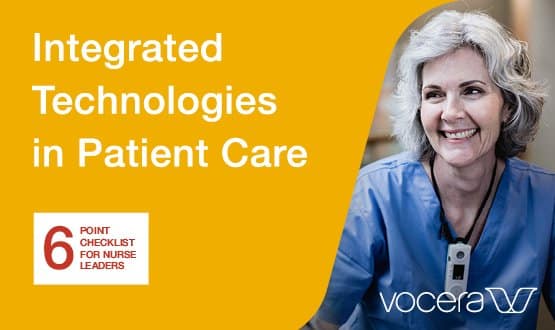
By Rhonda Collins – Chief Nursing Officer, Vocera Communications UK
Each year coinciding with Nurses Day, I author a CNO Perspective report which examines a topic of current importance to nurse leaders. This year’s report, Using Integrated Technologies to Solve Today’s Nursing Challenges: a How-to Guide for Nurse Leaders, focuses on the subject of digital transformation.
This topic is extremely relevant to solving the top-of-mind challenges nurse leaders are facing today, like how to attract and retain nurses, and how to enable nurses to communicate more easily with physicians and other members of the care team.
The report delves into how digital transformation is impacting and will continue to impact the discipline of nursing. We hope that you come away understanding what you can do about it so you can drive the change rather than have change happen to you.
Clinical Technology Decisions Need Your Expertise
In hospitals everywhere, conversations are taking place in which people are determining the technologies nurses will use at the bedside. We encourage you to be at the table and part of these conversations, and not to surrender your power to others.
As a nurse leader, you view yourself as an expert in the arena of patient care, not in the field of technology. Yet you have to get involved – because technology decisions affect your nurses and the patients they care for. Clinical technology decisions need your expertise.
6 Point Checklist for Nurse Leaders
Digital transformation demands a move away from the transactional point-solution approach and toward the strategic integrated-technology approach. Keep this checklist of guidelines and questions in mind as you participate in conversations and evaluate technology solutions:
- Is a clinical expert at the table for every discussion about technology clinicians will use? Don’t allow others to make your decisions for you.
- Have you begun with the end in mind? Always lead with the patient. Make sure the technology enables the nurse to interact with the patient and focuses on the patient as the center to streamline the nurse’s workflow. Your end result will be a better patient outcome and happier staff.
- Are the solutions you’re considering and the technology strategy you’re building user friendly? Make sure you’re setting up a sustainable workflow that makes it easier for nurses to get their job done.
- Does the solution solve more than one problem? Make sure it doesn’t solve one problem while creating three more.
- Is the solution sustainable? Make sure it will be able to grow and integrate throughout your organisation over time. Do you have expansion or facility construction in mind? Can the solution scale to support all locations within the extended system? If you change clinical practice guidelines, will you be able to customise the solution to support the new protocols?
- Have you incorporated the nurse perspective? Nurses are experts on the care environment and need to be part of defining technology requirements. Include nurses in the process of making decisions from the bottom up to help ensure their buy-in and adoption.
 |
|
| Our website: www.vocera.com/uk Twitter: @VoceraComm LinkedIn: www.linkedin.com/company/vocera-comm/ Facebook: www.facebook.com/VoceraComm [ssba]
|
|






